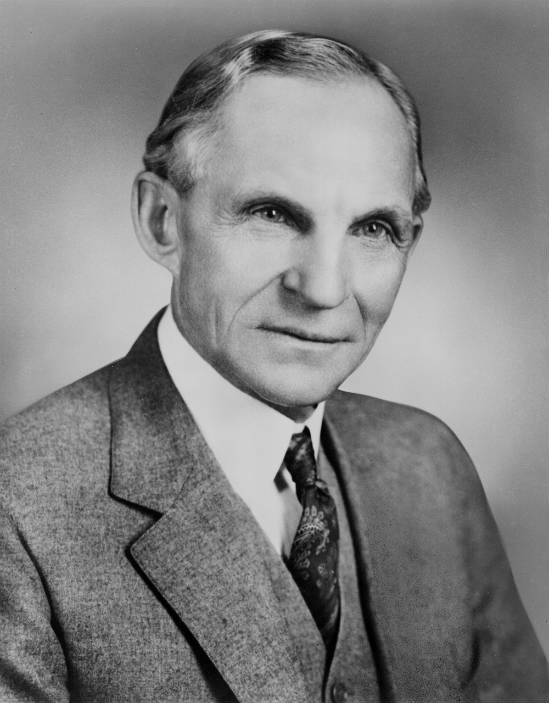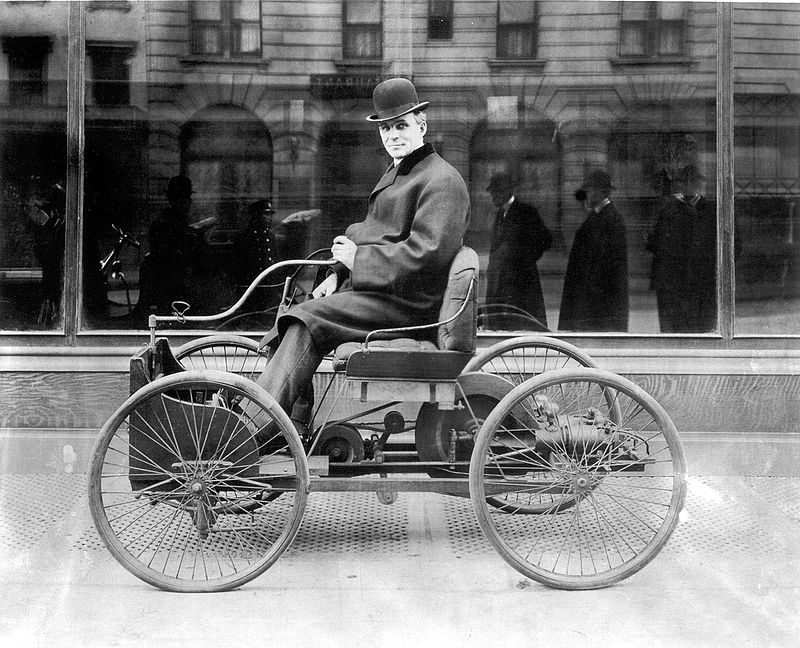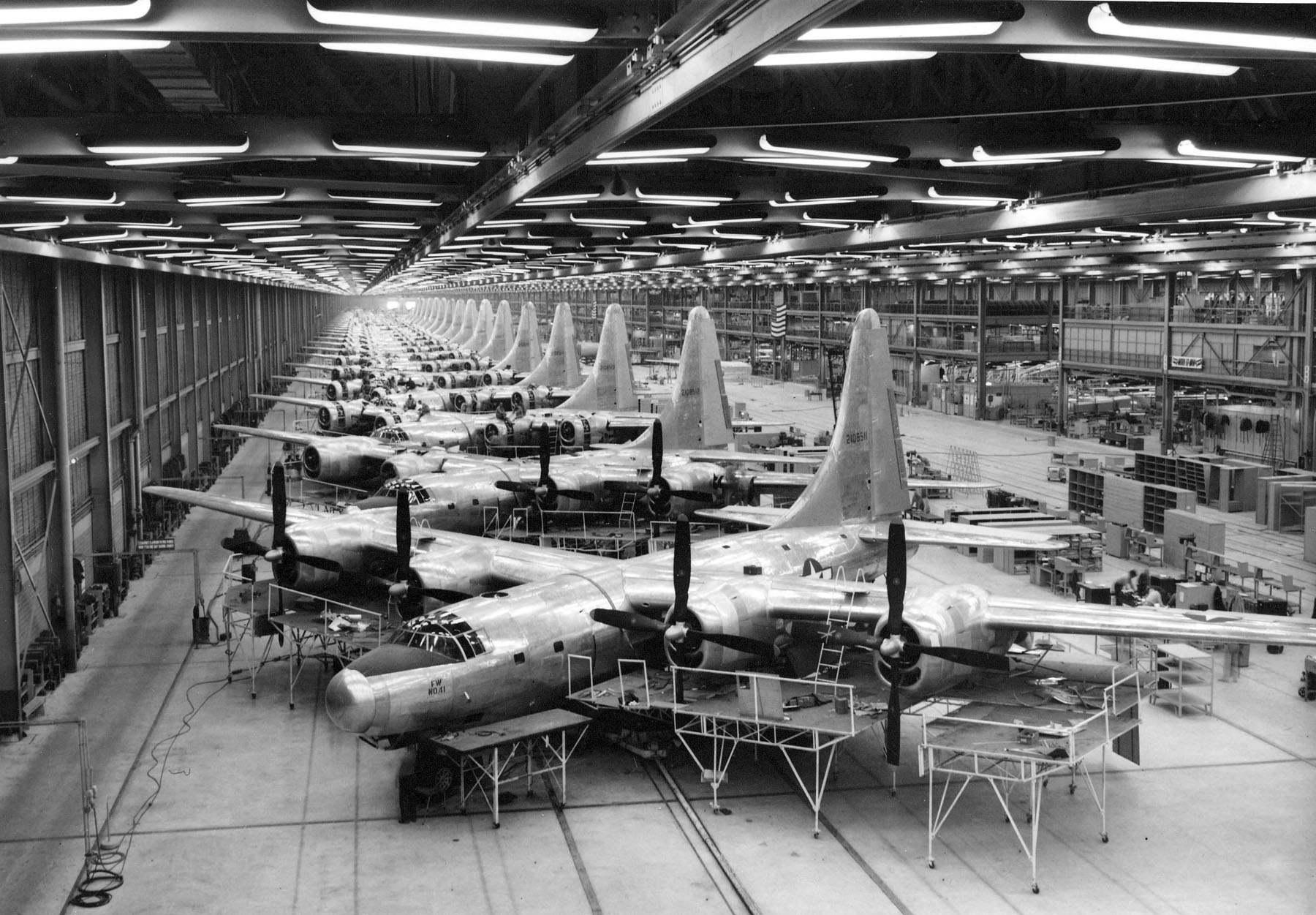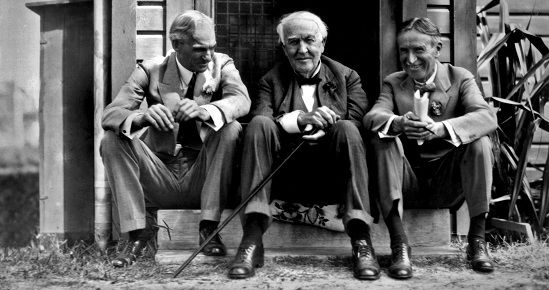By Toyeke Oswide
“I will build a motor car for the great multitude. It will be large enough for the family but small enough for the individual to run and care for. It will be constructed of the best materials, by the best men to be hired, after the simplest designs that modern engineering can devise. But it will be so low in price that no man making a good salary will be unable to own one—and enjoy with his family the blessing of hours of pleasure in God’s great open spaces.”

Henry Ford, the man who revolutionized the most possessed means of transport as we have today, was born on the thirtieth day of July, 1863 on a farm at Dearborn, Michigan. He was brought up in an environment where the drudgeries of farm labour were evident. This experience set him on a life course devoted to the innovations of machines that would eliminate the struggles of mankind at work. His mother often called him a born mechanic. Ford’s farm childhood lacked the pleasures of toys so he resorted to tools for machine-repair. He claimed in his later life, “In those days we did not have the toys of to−day; what we had were home made. My toys were all tools—they still are! And every fragment of machinery was a treasure.” Going to town, he always had his pockets full of nuts, washers and machine parts.
At twelve years of age, he encountered a road engine made for driving threshing machines and sawmills. This portable equipment was in its simplest form, a boiler built on wheels with a water tank and a trailing coal cart. Unlike any engine, this one had a chain for transmitting the power to the wheels and a man stood to steer the vehicle in motion. The machine was made by the then popular steam engine maker Nichols, Shepherd and Company. Ford stopped to inquire from the engineer in charge of the vehicle and he was glad to explain the working principles. The fashion of that engine was applied later to automobiles. Ford later made his own model of that machine and it performed excellently. Ford later expressed, “…from the time I saw that road engine as a boy of twelve right forward to today, my great interest has been in making a machine that would travel the roads.”Possessed by the spirit of machinery, Ford’s passion for them began to find expression in watch-repairing. He would take a broken watch and put it back in order. At thirteen, the young mechanic would couple the intricate parts of a watch together and at fifteen, he knew almost everything about watch-repairing.
Though brought up in a farm, Henry Ford confessed to having no interest in the venture but his father expected him to turn out a farmer some day. At seventeen, Ford left school and apprenticed at the machine shop of the Dry Dock Engine Works, a maritime manufacturing facility in Detroit. The outstanding Ford qualified to be a machinist long before his three-year term with the firm had expired. He soon took to nightly work at a jewelry repair shop doing what he loved— repairing watches. The young mechanic soon lost taste in the watch venture as he found it too easy. “I did not like the ordinary jewelry and watch making excepting where the job was hard to do.” he said.
Since the steam engine was invented, people had been talking about the idea of a horseless carriage. Before obsessing with the idea of the automobile for comfortable transport, Ford wanted this idea of the no-horse carriage deposited into the toiling on the farm—to make a machine that would be of tremendous benefit to farmers by speeding up their work and eliminating hard labour. He eventually built a tractor in his farm workshop.
Ford saw that people and even farmers were more interested in machines that would travel distances than in engines that would do farm work. It was this that spurred him into his lifework on the automobile.
Ford’s automobile experiments began with a steam car that worked with a kerosene-heated boiler. The boiler posed a hazard and required that the engine work under very high pressure. This was a fail for Ford. He carried on his experiments on a steam-powered road vehicle for two years and after a record of failures, lost hope in the thought of the automobile being run on steam.
A preview on the World of Science magazine had revealed to Henry Ford the use of illuminating gas for powering the Otto engine—a large stationary cylinder internal combustion four-stroke engine—designed by renown German inventor, Nikolaus Otto. Ford studied further publications to see in detail the development of this engine and how the illuminating gas could be replaced by a better fuel.
Ford got his chance to study the Otto engine indepth when he had to repair one at the Eagle Iron Works, Detroit in 1885. Two years later, he successfully built an engine running on the principles of this intricate piece of German machinery and it was in fact, a lighter version.
Though seeking to perform more experiments, Henry Ford returned to his father’s farm in Dearborn. Ford’s father expected him to take on his footsteps and become a farmer. Offering him forty acres of timberland provided he abandon any aspirations of becoming a machinist, Ford jumped at the offer but still serviced engines used by farmers and experimented on the gas engine in his spare time.
The lumber business was profitable for Ford, having acquired enough to start a family. On April 11, 1888, Henry Ford at twenty five, got married to Clara Jane Bryant who grew up in a farm closeby. They had only one son who would later oversee affairs at Ford’s global ‘car farm’.
The Machinist soon dropped all that was farm work from his life. In 1891, Ford moved with his wife to Detroit, where he got a job as night engineer for the Edison Electric Illuminating Company (established by Thomas Edison). The job gave Ford an opportunity to learn about electricity though Ford continued experimenting on his horseless carriage. In 1892, he found success. Henry Ford had completed his first motor car called the Quadricycle which ran on gasoline and added his final touches in 1893. This buggy-like car had a two cylinder engine that developed a four horsepower output. Though crude, it was a fine piece of technology then. The vehichle ran on four bicycle wheels, was steered with a tiller and had no reverse. This first car in Detroit achieved a top speed of only 32kmph. Henry Ford had to get a permit from the Mayor to drive his car and was for some time the only licensed driver in America.

Ford sold the car to a Charles Ainsley for $200 in 1896 and used that money to improve on his invention. He would buy the car back for $100 a few years later. Henry Ford set his eyes to mass producing his invention but felt he had to make it better. Not wanting to hurry, he began his work on his second automobile that same year. His goal was to achieve a lighter vehicle and he didn’t fail in that respect. Ford’s second automobile also adopted a gear system whereas the previous model used a belt drive. The belt system was prone to failure especially in hot weather.
Ford worked on his automobile side-by-side his job at Edison’s company. He was promoted to Chief Engineer and earned a salary of $150 a month but his superior objected to his experiments, seeing no future in the gas-engine but in electricity only. Ford had to choose between his good job and the automobile. He followed his heart.
Ford used his entire living on the experiment and his wife supported his view on the importance of the automobile. Getting financial backing from a few investors, Ford founded the Detroit Automobile Company with himself being the chief engineer and holding small amount of stock. The company was only profit driven and made cars based on Ford’s first model. Ford was pressured by the investors and had no room express his innovative prowess. He resigned in March, 1902. The company later became the Cadillac Company.
His vision for the car unwavering, Ford kept on experimenting. The automobile had progressed from the initial stage of just merely working to a point where it had to be fast. Ford met with Alexander Winton of Cleveland, maker of the quick Winton car and the fastest driver in America then. A race was organized and Ford used a car he had built for speed. Ford defeated Winton and got some publicity. He got into more races, attracted investors and founded the Ford Motor Company on June 16, 1903.
The company started out in a rented carpenter shop with them assembling parts based on Ford’s designs by different manufacturers. Ford believed that the service-orientation of his company was key to its success. He wanted the price of the automobile low and to ensure that the customer got the best service after purchase. He adopted the slogan, “When one of my cars breaks down I am to blame.”
Ford sought ways of cutting down the weight of the car and experimented on new materials. In the first year, the Ford Motor Company built the Model A that sold for $850. It developed 8 horsepower. They sold all 1,708 units they made in the first year. That was successful. Ford used advertising effectively to capture buyers for his great car.
The next year, the company worked on three new models—the Model B, Model C and Model F. They sold for $2000, $900 and $1000 respectively. The total sales were 1,695 cars which was lower than that of the first year.
The small space of a carpenter’s shop had become inadequate. Ford built a three-storey plant for his company, enabling them begin both manufacturing and assembling. Not wanting to fall prey of investors, Henry Ford decided it was time he took full control of his company. With the money he earned, he bought enough stock to own fifty eight and a half percent of the company. Ford’s son Edsel, would purchase the remaining forty one and a half percent for $75,000,000 in 1919. That is why today, Ford is still a family business.
Ford could now change the company’s policy, owning more half of the available stock. He reduced the prices of his cars significantly and the public responded with more sales. They sold 8,423 cars (nearly five times as much as the previous year). The company continued to experiment on new cars and make more sales. Five years after its inception, the Ford Motor Company was now considered very prosperous and had begun shipping cars to Europe.
Ford believed the core values of the car were quality, simplicity, power, reliability, lightness and control. He designed a revolutionary car, the Model T, to have all these attributes. Ford made the design so simple that it could be repaired by almost any mechanic. He also brought about another innovation— the manufacture of spare parts for the car which made it cheaper to buy a new part than have the old one fixed. The car was rolled out in 1908 and was a huge success.

The business grew and in 1909, Ford moved to a bigger factory in Highland Park, Michigan. Cars were being produced on a scale the world had never known and Ford continued with his vision of mass producing a cheap car. Ford innovated again, his factory changed the world by introducing the moving assembly line system in production. This cut down the time of manufacture significantly. In March 1914, it took five hours and fifty-six minutes to assemble a car. He built more plants and gave each plant its essential production focus. The River Rouge plant built in 1917, was a colossal factory that manufactured both car and tractor. By 1927, all steps in the manufacture of a car from the refinement of iron ore to the final assembly, could be carried out in the edifice.

Henry Ford improved the lot of his workforce paying $5 ($120 in today’s money) per day, making them able to afford the cars they made. This had never been done in any industrial establishment. This was highly profitable for Ford as the incentive kept the best staff in the business and eliminated turnover. An enemy of wasted charity, he also provided employment for the disabled believing they deserved to earn a living.
Ford regarded his company as an instrument of service, pouring back the huge profits it made into the business. At a time, the profits were so large that the company voluntarily returned $50 dollars to each purchase of a car.
World War I broke out during Woodrow Wilson’s tenure as President of the United States. Ford held views against the war and financed the Peace Ship expedition to Stockholm. It wasn’t long before the US would declare war on the Central Powers and leave Ford no choice but to use his factories as mega-kitchens for war machines. The Ford Motor Company would become a major military contractor for the United States Government again during World War II.

Ford named his twenty-six year old son president of his company in 1919. Edsel brought in fresh ideas into the company and suggested for a new model after the Model T. Though his father disagreed, slumping sales figures and stolen market share by the likes of Chrysler made him rethink. Henry Ford made his last great innovation in the automobile by the design of the V8 engine in 1932 which many vehicles still adopt today.
Ford was awarded the Grand Cross of the German Eagle, the highest award by a foreigner in Nazi Germany but refused to participate in their cause. Though denying his involvement in anti-Semitic articles published by the Dearborn Independent (a newspaper he bought), many believed Ford was against Jews.
Henry Ford went on vacations with Thomas Edison in his later years. The two shared ideas though Edison being an Electricity evangelist, believed strongly that the internal combustion engine would still be very relevant. After the shocking death of his son in 1943, Ford resumed as president of his company. Henry II, his grandson, was given the baton two years later. Henry Ford passed away on April 7,1947 at age 83.


Governor Makinde Presents Staff Of Office To 43rd Olubadan Of Ibadanland
Muhammadu Sanusi II Returns As Emir Of Kano After Four-Year Ouster
Ohinoyi of Ebiraland, HRM Ado Ibrahim, Passes Away At 94
Alaafin Of Oyo, One Of Nigeria’s Most Prominent Kings, Lamidi Adeyemi Dies At 83